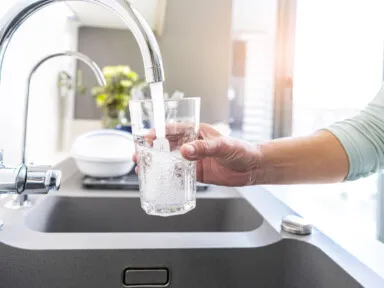Uncovering the Hidden Dangers in Your Well Water—Understanding Water Contamination Symptoms
Are you confident that the water from your private well is safe to drink? Drinking water quality is crucial for maintaining good health. Many people who rely on a private well water source might not be aware of the hidden contaminants lurking beneath the surface. Recognizing water contamination symptoms early can protect your health and improve your quality of life.
At Leaf Home Water Solutions, we specialize in ensuring your drinking water is clean and safe, leveraging our expertise and reliable water filtration solutions.
Signs of Contaminated Well Water
Identifying the signs of contaminated well water is crucial for maintaining a healthy home environment. Here are some common water contamination symptoms to watch out for:
Murky or Cloudy Appearance
If your well water looks murky or cloudy, it could indicate the presence of suspended solids, such as dirt, silt, or organic matter. This cloudiness often suggests that the water supply is improperly filtered and might contain harmful microorganisms.
Visible Sediment in Water
Finding sediment in your drinking water is a clear sign that the well water is contaminated. This sediment can come from runoff or erosion, carrying various pollutants that can affect your health and damage your water systems.
Oily Film on Water
An oily sheen on surface water might suggest the presence of petroleum products or other hydrocarbons. These contaminants can enter your well through industrial runoff or improper disposal practices, posing significant health risks.
Scale or Scum Buildup in Pipes, Showerheads, and Faucets
Mineral deposits, like calcium and magnesium, can accumulate in pipes and fixtures, leading to scale buildup. If you notice white or greenish deposits, your water might have high hardness levels, affecting its taste and safety.
Brown, Red, or Green Stains on Sinks, Clothes, and Appliances
Discolored stains on household items usually indicate high levels of iron, manganese, or algae in your well water. If ingested over time, these contaminants can cause aesthetic issues and potential negative health concerns.
Rotten Egg or Chlorine Smell
A foul smell resembling rotten eggs indicates hydrogen sulfide gas, while a chlorine-like odor might mean there’s an excess of disinfectants. Both situations signal that your water needs further testing and treatment.
Salty, Soapy, Metallic, or Chemical Taste
Unusual tastes in drinking water are red flags for contamination. A salty taste suggests the presence of sodium or chloride, while soapy or chemical flavors might indicate detergents or industrial chemicals. A metallic taste often implies high levels of metals like lead or copper.
Rusty Silverware
Rust stains on silverware are a telltale sign of iron contamination in your water. This affects the appearance of your utensils and poses potentially adverse health effects if ingested frequently.
Can Well Water Make You Sick?
Yes, contaminated well water can make you sick. Harmful microorganisms such as bacteria, viruses, and parasites can thrive in untreated water, leading to:
- Gastrointestinal illnesses
- Skin infections
- Anemia
- High blood pressure
- Hepatitis
Installing a water filtration system can help remove these contaminants, ensuring your water is safe to drink and use. Various types of water treatment methods are available to remove impurities from well water. These include:
- Filtration Systems: Filtration systems use porous materials, such as sand, carbon, or ceramic, to filter out impurities and particles from water.
- Ultraviolet (UV) Purification: UV purification uses UV light to kill harmful microorganisms in the water by disrupting their DNA and preventing reproduction.
- Reverse Osmosis (RO): Reverse osmosis is a process that removes dissolved solids and larger particles like fluoride from water by forcing them through a semipermeable membrane.
Visit the EPA Private Drinking Water Wells page for additional information on wells, groundwater, and public health safety.
Common Well Water Contaminants
Well water can be contaminated by various substances that pose significant health risks. Here are some common germs and contaminants found in well water:
- Microorganisms like bacteria, viruses, and parasites can infiltrate well water through fecal contamination, agricultural runoff, or improperly treated sewage. For instance, E. coli can cause severe gastrointestinal issues, including diarrhea, cramps, and vomiting. Viruses such as Norovirus can lead to stomach flu, characterized by nausea and intense stomach pain. Parasites like Giardia, from animal waste or human sewage, cause prolonged diarrhea and weight loss. These microorganisms can make drinking water unsafe, highlighting the need for proper filtration.
- Heavy Metals like arsenic and lead can leach into well water from natural deposits or industrial pollution. High concentrations of these heavy metals are particularly harmful, leading to severe neurological damage, developmental issues in children, and increased cancer risks.
- Nitrates/Nitrites often enter well water through agricultural runoff containing fertilizers or untreated sewage. High levels of these compounds are dangerous for infants, causing a condition known as “blue baby syndrome,” which affects the blood’s ability to carry oxygen.
- Fluoride from natural sources: while low fluoride levels can benefit dental health, excessive amounts from natural sources can cause dental fluorosis (discoloration of teeth) and, in severe cases, increase the risk of bone fractures.
- Pesticides and herbicides like atrazine can contaminate well water through agricultural runoff. These chemicals are linked to hormonal imbalances, reproductive issues, and birth defects in humans.
Understanding these pathogens and pollutants and their sources helps highlight the importance of regular water testing and investing in a reliable filtration system. Leaf Home Water Solutions is dedicated to protecting your health by providing effective solutions tailored to your home’s needs.
You can find additional information on well water contaminants here or on the CDC website.
What to Do If Your Well Water Is Contaminated
Stop using water sourced from the well: Immediately stop using the water for drinking, cooking, and bathing to prevent exposure to harmful contaminants. In the meantime, you can use reusable bottled water for drinking.
Have the well water tested to identify contaminants: Professional testing is crucial to pinpoint the exact contaminants present in your water. Knowing what’s in your well water helps determine the necessary treatment to make your water safe again.
Install a well water filter to make it safe: A comprehensive water filtration system can effectively remove contaminants. This ensures that your water remains clean and safe for everyday use.
Take Action for Cleaner Water
Recognizing the signs of contaminated well water and taking necessary precautions can protect your immune system and improve your quality of life. If you suspect that your well water is contaminated, don’t wait to take action. Leaf Home’s water filtration solutions offer a reliable way to keep your water clean and safe, protecting you and your family from the hidden dangers of water contamination. Don’t risk drinking dirty water—trust Leaf Home for clean, safe water.
Schedule a free home water test and discover what’s lurking in your water.
Frequently Asked Questions
How do I know if I am sick from contaminated water?
Symptoms of illness from contaminated water include gastrointestinal distress, skin rashes, and flu-like symptoms. Consult a healthcare provider if you experience these waterborne disease symptoms after consuming well water.
How long does it take to get sick from polluted water?
Waterborne illnesses can occur within hours to days after exposure, depending on the contaminant and your health status.
What are the side effects of contaminated water?
Side effects of contaminated water range from mild stomach cramps and diarrhea to severe infections and long-term health issues such as neurological damage from heavy metals.
What are the signs of polluted water?
Signs of polluted water include unusual taste, color, or smell, as well as visible sediments or oil films. Regular testing is essential for early detection.



